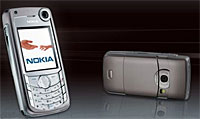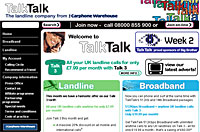 There’s a big battle going on for your landline, with the Carphone Warehouse limbering up to get in some telling punches into BT’s sector dominance.
There’s a big battle going on for your landline, with the Carphone Warehouse limbering up to get in some telling punches into BT’s sector dominance.
TalkTalk UK – Carphone’s fixed line subsidiary – is looking to snaffle ten per cent of the UK’s fixed line market within the next three years, after recording what they describe as an “outstanding year”.
The company has soared into profit in only its second year of operation, despite hefty investment and marketing costs, with more than 920,000 fixed line users generating revenues of £123.6m (~US$225m~€183m).
Heady on success, sharp suited TalkTalk execs have sent the flipcharts flapping and come up with an ambitious target of signing up two million residential consumers by March 2008 – that’s one in ten of the UK’s fixed line market.
TalkTalk also plans to simplify the process for customers paying their call charges and line rental on a single bill – or “terminating the billing relationship with BT” as they like to call it.
 Chief exec Charles Dunstone was ready with a quote: “We are now well on the way to developing a broad-based telecoms group, providing mobile and fixed line services to individuals and businesses across ten countries.”
Chief exec Charles Dunstone was ready with a quote: “We are now well on the way to developing a broad-based telecoms group, providing mobile and fixed line services to individuals and businesses across ten countries.”
“We have now proved that TalkTalk has all the ingredients to become the major alternative force in UK residential communications, and further regulatory change over the next year should allow us to move to the next level in both scale and range of service.”
The parent company, Carphone Warehouse, have also released bumper figures, reporting a 33.8% rise in pre-tax profits to £102.1 million (~US$185m ~€151m) in the 12 months to the end of March, against £76.3 million (~US$138m ~€113m) for the same period a year ago.
Turnover hopped, skipped and jumped up 27% per cent to £2.35 billion, operating profit soared up 45% to £107 million (~US$195m ~€158m), with Carphone Warehouse signing up 6.5 million new customers to mobile and fixed-line telephone services during the period (21.6 per cent higher than new connections for the previous year).
 Crucially, revenues from telecoms services were up 45% to £804 million (~US$1,462m ~€1,190m), with operating profit flying up 50% to £22.5 million (~US$41m ~€33m).
Crucially, revenues from telecoms services were up 45% to £804 million (~US$1,462m ~€1,190m), with operating profit flying up 50% to £22.5 million (~US$41m ~€33m).
“Our year-to-date connections growth of 20 per cent is particularly encouraging, especially in the context of a weaker consumer environment in the UK,” purred Charles Dunstone. “We remain confident of the outlook,” he added, before announcing that he was selling his first tranche of 6 million shares, or 2 percent, in the company.
 The European Commission has announced plans to create a single set of European Union rules on broadcasting and the wireless spectrum.
The European Commission has announced plans to create a single set of European Union rules on broadcasting and the wireless spectrum. Europe is also looking to free up the highly lucrative wireless spectrum – currently worth something like €9 billion (~US$11bn ~£6bn) a year – and hopes that digital frequencies used by services such as mobile phone operators, police radar and radio will be brought under centralised EU control by the end of 2005.
Europe is also looking to free up the highly lucrative wireless spectrum – currently worth something like €9 billion (~US$11bn ~£6bn) a year – and hopes that digital frequencies used by services such as mobile phone operators, police radar and radio will be brought under centralised EU control by the end of 2005.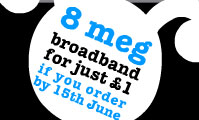 Bulldog Communications, the Internet and telecom group owned by Cable & Wireless, is rolling up its sleeves and shouting “Oy! Let’s be ‘aving you!” at its rivals as it doubles the speed of its broadband offering to a super-swifty 8 megabits-per-second from 4 megabits, and spread it across the UK.
Bulldog Communications, the Internet and telecom group owned by Cable & Wireless, is rolling up its sleeves and shouting “Oy! Let’s be ‘aving you!” at its rivals as it doubles the speed of its broadband offering to a super-swifty 8 megabits-per-second from 4 megabits, and spread it across the UK.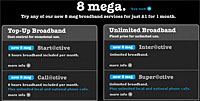 “Eight meg from Bulldog, with no download caps, gives customers the freedom to use the Internet as they wish,” he growled before retiring to his executive kennel.
“Eight meg from Bulldog, with no download caps, gives customers the freedom to use the Internet as they wish,” he growled before retiring to his executive kennel. A survey by Cingular Wireless has revealed that men spend more time yakking on mobiles than women.
A survey by Cingular Wireless has revealed that men spend more time yakking on mobiles than women.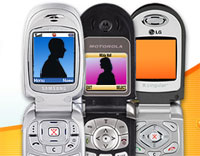 Women aren’t afraid to get snapping either, with 60 percent using their camera feature frequently or occasionally against 40 percent of men using it as often.
Women aren’t afraid to get snapping either, with 60 percent using their camera feature frequently or occasionally against 40 percent of men using it as often. Research from BT shows that the number of users connecting to the Internet via broadband has overtaken dial-up subscriptions for the first time, with 7.4 million broadband customers (including cable) now online.
Research from BT shows that the number of users connecting to the Internet via broadband has overtaken dial-up subscriptions for the first time, with 7.4 million broadband customers (including cable) now online. High speed connections are also good news to those selling goods and services online, with an explosive growth in the consumer market for buying media online, such as films, music and television.
High speed connections are also good news to those selling goods and services online, with an explosive growth in the consumer market for buying media online, such as films, music and television. Two million cable customers now enjoy broadband connectivity through NTL and Telewest.
Two million cable customers now enjoy broadband connectivity through NTL and Telewest. Cardiff vicar Reverend Kimber is hoping that by introducing wireless broadband access from the pews of his city centre church, more people will be encouraged to join his flock at St John’s Church.
Cardiff vicar Reverend Kimber is hoping that by introducing wireless broadband access from the pews of his city centre church, more people will be encouraged to join his flock at St John’s Church. After Kimber approached BT, the company agreed to fill in the gap in Cardiff’s wireless broadband network and fitted the church with its own Openzone node, providing access to surfers sitting in the corner of the north aisle at St John’s.
After Kimber approached BT, the company agreed to fill in the gap in Cardiff’s wireless broadband network and fitted the church with its own Openzone node, providing access to surfers sitting in the corner of the north aisle at St John’s. The Training Foundation has launched its Ready for Work online training programme, an employment-awareness course free to all young people in (or recently in) full-time education and those in modern apprenticeships.
The Training Foundation has launched its Ready for Work online training programme, an employment-awareness course free to all young people in (or recently in) full-time education and those in modern apprenticeships. Each self study course ends with a short test to check the learner’s understanding, with an 80% or better grade qualifying the student for an optional Ready for Work Certificate and Ready for Work Handbook.
Each self study course ends with a short test to check the learner’s understanding, with an 80% or better grade qualifying the student for an optional Ready for Work Certificate and Ready for Work Handbook. David Frost, Director General of the British Chambers of Commerce roared his approval: “We need initiatives such as Ready for Work, which can help to ensure that young people leaving full-time education and training are equipped with skills that are both relevant for the workplace and will help advance their careers.”
David Frost, Director General of the British Chambers of Commerce roared his approval: “We need initiatives such as Ready for Work, which can help to ensure that young people leaving full-time education and training are equipped with skills that are both relevant for the workplace and will help advance their careers.” Poor old granny. All she wants to do is ring up a cab to take her home from the bingo, but her hi-tech, Bluetooth enabled, all-vibrating, MP3-playing, camera-toting, WAP-enabled phone is trying to get her to download the latest Blink 182 ringtone and asking for her GSM details.
Poor old granny. All she wants to do is ring up a cab to take her home from the bingo, but her hi-tech, Bluetooth enabled, all-vibrating, MP3-playing, camera-toting, WAP-enabled phone is trying to get her to download the latest Blink 182 ringtone and asking for her GSM details. Despite the corporate wires buzzing with office gossips, chatting clerks, bored employees and downloading demons, a survey warns that IM remains unregulated in the workplace.
Despite the corporate wires buzzing with office gossips, chatting clerks, bored employees and downloading demons, a survey warns that IM remains unregulated in the workplace. Some 25% of particularly bored office workers have also used IM to download music and film trailers at work.
Some 25% of particularly bored office workers have also used IM to download music and film trailers at work. For example, anti-virus firm Symantec reported a 400 percent increase in IM and peer-to-peer (P2P) networking viruses, worms and trojans over the last 12 months.
For example, anti-virus firm Symantec reported a 400 percent increase in IM and peer-to-peer (P2P) networking viruses, worms and trojans over the last 12 months.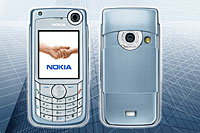 The Nokia 6680 imaging smartphone has been declared the new ‘Best in Class’ 3G device according to a report by Strategy Analytics.
The Nokia 6680 imaging smartphone has been declared the new ‘Best in Class’ 3G device according to a report by Strategy Analytics.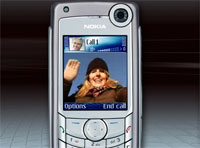 The report noted strong deviations (oo-er!) in the results of these evaluations by gender with the lay-deees preferring the Sony Ericsson and NEC devices, whereas the geezers exhibited a strong preference for the Nokia and Motorola handsets.
The report noted strong deviations (oo-er!) in the results of these evaluations by gender with the lay-deees preferring the Sony Ericsson and NEC devices, whereas the geezers exhibited a strong preference for the Nokia and Motorola handsets.